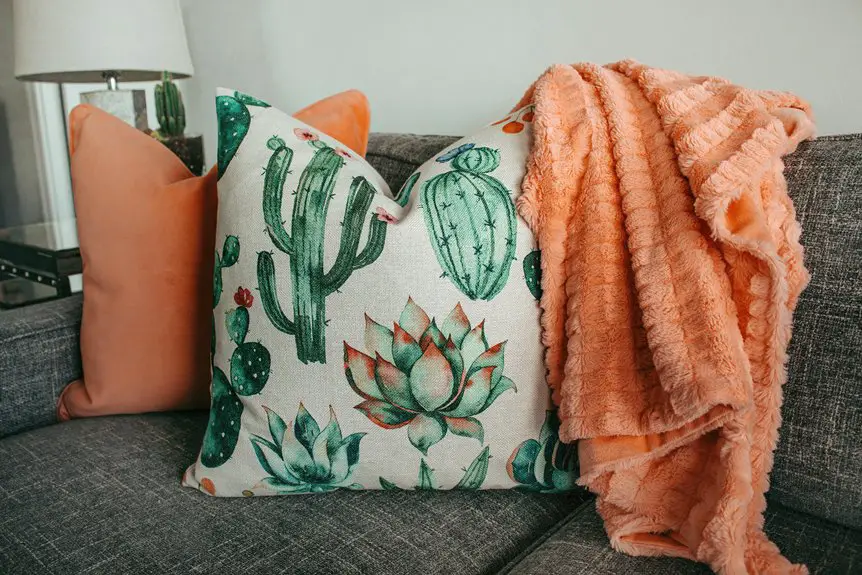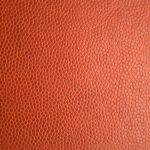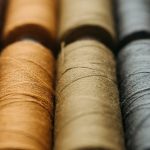If you want a sofa fabric that’s durable, stain-resistant, and easy to maintain, 100% polypropylene is a solid choice. It handles everyday wear well, resists fading, and comes at a budget-friendly price. However, it’s less breathable, can attract static, and isn’t the most eco-friendly option. While it may feel a bit synthetic compared to natural fabrics, its practical benefits make it popular. Keep exploring to discover how it matches your lifestyle and style needs.
Table of Contents
Key Takeaways
- Polypropylene fabric is durable, stain-resistant, and easy to clean, making it ideal for everyday sofa use.
- It offers a smooth texture with vibrant color retention but lacks the natural feel of cotton or linen.
- The fabric is lightweight and resists fading but can generate static and attract pet hair.
- Polypropylene has limited breathability and can be sensitive to high heat, affecting comfort and longevity.
- Environmentally, it has a larger carbon footprint and recycling challenges but provides good value and durability at a budget-friendly cost.
What Is 100% Polypropylene Fabric?
100% polypropylene fabric is a synthetic material made entirely from polypropylene fibers. When you use this fabric for sofas, you get a durable and lightweight option that resists stains and moisture.
Polypropylene is a type of plastic polymer, so it doesn’t absorb water easily, making spills less of a hassle to clean up. You’ll also notice it stands up well to daily wear and tear, which is great if your sofa sees a lot of use.
Because it’s synthetic, it doesn’t wrinkle or shrink like some natural fibers might. While it’s not natural, it’s designed to mimic some of the comfortable qualities you want in upholstery, providing a practical choice for your sofa’s fabric without sacrificing ease of maintenance.
Key Characteristics of Polypropylene Fabric
You’ll appreciate polypropylene fabric for its impressive durability and strength, making it ideal for everyday use.
Its texture offers a comfortable feel while maintaining a clean, attractive appearance.
Plus, you won’t have to worry much about stains, as this fabric resists them effectively.
Durability and Strength
Although polypropylene fabric feels lightweight, it boasts impressive durability and strength that make it ideal for sofas.
You’ll find it resists wear and tear much better than many natural fibers. This fabric stands up well to daily use, including heavy foot traffic and frequent sitting, without easily developing tears or frays.
Polypropylene’s resistance to stretching and shrinking also means your sofa will maintain its shape over time. Plus, it handles exposure to sunlight without weakening, so it won’t fade or degrade quickly if your sofa sits near a window.
If you want a sofa fabric that combines toughness with long-lasting performance, polypropylene is a smart choice that won’t disappoint you.
Texture and Appearance
When choosing fabric for your sofa, texture and appearance play an essential role in both comfort and style. Polypropylene fabric offers a smooth, slightly silky feel that many find pleasant to touch. Its appearance tends to be bright and vibrant due to excellent dye absorption, making colors pop and last longer without fading. You’ll appreciate its subtle sheen, which adds a modern look to your furniture. However, polypropylene can sometimes feel less natural compared to cotton or linen.
| Characteristic | Polypropylene Fabric |
|---|---|
| Texture | Smooth, slightly silky |
| Appearance | Bright, vibrant colors |
| Sheen | Subtle sheen |
| Feel | Synthetic, less natural |
| Style Suitability | Modern, casual |
Resistance to Stains
Polypropylene fabric resists stains better than many other sofa materials, making it a smart choice for busy households. When spills happen, you won’t have to panic or rush to clean immediately.
Its stain resistance comes from its non-porous fibers that repel liquids and dirt. Here’s why you’ll appreciate polypropylene’s stain resistance:
- Liquids bead up on the surface, preventing deep absorption.
- Most common spills wipe off easily with a damp cloth.
- It withstands frequent cleaning without losing color or texture.
- Resistant to oils and grease, common culprits in stubborn stains.
This makes polypropylene sofas practical and low-maintenance, perfect if you want to keep your furniture looking fresh without extra effort.
Advantages of Using Polypropylene for Sofas
Because you want a sofa fabric that balances durability and comfort, polypropylene stands out as an excellent choice.
You’ll appreciate its exceptional resistance to wear and tear, making it ideal for everyday use. Polypropylene’s stain resistance means you won’t worry about spills ruining your sofa, and it’s easy to clean with just mild soap and water.
The fabric’s lightweight nature guarantees your sofa won’t feel bulky, while its softness adds to your comfort. Additionally, polypropylene is colorfast, so your sofa maintains its vibrant look even after prolonged exposure to sunlight.
Plus, its affordability means you get great value without sacrificing quality. Overall, choosing polypropylene helps you enjoy a practical, comfortable, and attractive sofa that fits well in busy households.
Potential Drawbacks of Polypropylene Upholstery
Although polypropylene offers many benefits, you should consider some potential drawbacks before choosing it for your sofa upholstery.
Here are four key points to keep in mind:
- Heat Sensitivity: Polypropylene can melt or deform if exposed to high temperatures, so avoid placing hot objects on your sofa.
- Static Electricity: This fabric tends to generate static, which might attract dust and pet hair, requiring more frequent cleaning.
- Limited Breathability: Polypropylene doesn’t breathe well, which can make your sofa feel less comfortable in warm weather.
- Environmental Impact: Being a synthetic plastic, polypropylene isn’t biodegradable and can pose environmental concerns when disposed of.
Weigh these factors carefully to decide if polypropylene fits your lifestyle and preferences.
Durability and Wear Resistance of Polypropylene Sofas
You’ll find that polypropylene sofas hold up well under daily use, thanks to their strong fiber structure.
They resist abrasion better than many other fabrics, making them ideal for high-traffic areas.
Knowing this helps you choose upholstery that stays looking fresh longer.
Strength Under Daily Use
Many polypropylene sofas stand up well to daily use, thanks to the fabric’s inherent strength and resistance to wear. When you choose polypropylene, you get a sofa that can handle everyday demands without easily showing signs of stress.
Here’s why it performs so well:
- Polypropylene fibers have high tensile strength, resisting stretching and tearing.
- The fabric resists pilling, keeping your sofa looking smooth and neat over time.
- It withstands exposure to sunlight better than many other materials, reducing fading.
- Polypropylene’s resistance to moisture helps prevent mold and mildew buildup.
With these qualities, your sofa can maintain its shape and appearance even with frequent sitting, making polypropylene a practical choice for busy households.
Resistance to Abrasion
Building on polypropylene’s ability to handle daily wear, its resistance to abrasion plays a key role in keeping your sofa looking fresh. This fabric resists rubbing and friction, so it won’t easily show signs of wear from frequent use.
If you have kids or pets, polypropylene’s durability helps prevent tears and pilling, maintaining your sofa’s smooth texture over time. You won’t have to worry about scuffs or rough patches developing quickly.
However, while it’s tough, polypropylene isn’t completely immune to damage from sharp objects or excessive scraping. Regular cleaning and gentle care will help preserve its abrasion resistance.
Cleaning and Maintenance Tips for Polypropylene Fabric
Keeping your polypropylene fabric sofa looking fresh is easier than you might think. This durable material resists stains and holds up well with regular care.
Polypropylene fabric sofas stay fresh and stain-resistant with simple, regular care.
To maintain its appearance and longevity, follow these simple tips:
- Vacuum weekly using an upholstery attachment to remove dust and debris.
- Spot clean spills immediately with a mild detergent and warm water; avoid harsh chemicals.
- Use a soft brush to gently lift dirt from the fabric without damaging the fibers.
- Rotate cushions regularly to prevent uneven wear and fading from sunlight.
Comfort and Feel of Polypropylene Compared to Other Fabrics
When you sit on a polypropylene sofa, you’ll notice its texture feels different compared to natural fabrics like cotton or wool.
You might wonder how it handles breathability and temperature, especially during long use.
It’s also important to reflect on how durable it feels over time and whether it maintains comfort as it wears.
Texture and Softness Comparison
Texture plays an essential role in how comfortable a sofa feels, and polypropylene fabric offers a unique balance between softness and durability.
When you compare it to other materials, here’s what you’ll notice:
- Polypropylene feels smooth but slightly less plush than cotton or velvet.
- It resists pilling, so the texture stays consistent over time.
- Unlike leather, it lacks that firm, cool surface and feels softer to the touch.
- It’s less breathable than natural fibers, affecting how soft it feels overall.
You’ll appreciate polypropylene’s texture if you want a sofa that feels comfortable without sacrificing toughness.
It’s a smart choice if you want something soft enough to relax on but still sturdy enough to handle everyday use.
Breathability and Temperature Control
Although polypropylene fabric offers durability and softness, its breathability and temperature control differ greatly from other materials. You’ll find polypropylene less breathable, which means it can trap heat and moisture, making it less comfortable in warm conditions compared to natural fabrics like cotton or linen.
| Fabric Type | Breathability |
|---|---|
| Polypropylene | Low |
| Cotton | High |
| Linen | Very High |
| Polyester | Moderate |
When it comes to temperature control, polypropylene tends to retain heat, so you might feel warmer sitting on a polypropylene sofa. In contrast, cotton and linen allow better air circulation, helping you stay cool. If you prioritize breathability and coolness, polypropylene might not be your best bet, especially in hot climates.
Durability and Wear Feel
Polypropylene fabric stands out for its impressive durability, making it a practical choice if you want a sofa that withstands daily use without showing wear quickly.
When comparing comfort and feel to other fabrics, you should consider these points:
- Polypropylene resists pilling and fading, keeping your sofa looking fresh longer.
- It feels slightly rougher than natural fibers like cotton or linen but softens with use.
- Its synthetic nature means it doesn’t breathe as well, which might affect comfort in hot climates.
- You’ll appreciate its stain resistance and ease of cleaning, perfect if you have kids or pets.
Environmental Impact and Sustainability Considerations
When you choose materials for your sofa, understanding their environmental impact can guide you toward more sustainable options.
Polypropylene is a synthetic fabric derived from non-renewable petroleum, so it has a larger carbon footprint compared to natural fibers. However, it’s lightweight and durable, which means it often requires less frequent replacement, reducing waste over time.
Polypropylene’s durability and light weight can offset its higher carbon footprint by reducing waste through less frequent replacement.
Recycling polypropylene can be challenging since it’s not biodegradable, and improper disposal contributes to plastic pollution. If sustainability matters to you, look for sofas made with recycled polypropylene or brands committed to eco-friendly production practices.
While polypropylene isn’t the greenest option, its long lifespan and potential for recycling make it a reasonable choice if you balance durability with environmental concerns.
Popular Styles and Colors Available in Polypropylene Upholstery
Choosing the right style and color for your sofa can transform your living space, and polypropylene upholstery offers a wide range of options to fit your taste. This fabric adapts well to various designs and hues, making it easy to match your decor.
Here are popular styles and colors you can expect:
- Solid Colors: From neutral tones like beige and gray to vibrant blues and reds, polypropylene fabrics come in many shades to complement any room.
- Textured Weaves: You can find polypropylene with subtle textures that add depth without overwhelming your space.
- Patterns: Geometric and floral patterns appear frequently, offering playful or classic vibes.
- Matte and Glossy Finishes: Depending on your preference, you can choose a soft matte look or a slight sheen for a modern touch.
With these options, you’re sure to find a polypropylene sofa that suits your style perfectly.
Cost Comparison: Polypropylene vs. Other Sofa Fabrics
How does the cost of polypropylene sofas stack up against other fabric options?
You’ll find polypropylene is one of the more budget-friendly choices. Compared to natural fabrics like leather or linen, polypropylene is considerably cheaper, making it a great option if you want durability without breaking the bank.
While cotton and polyester might be similarly priced, polypropylene offers better stain resistance and longevity, giving you more value for your money.
On the higher end, fabrics like velvet or designer weaves tend to cost more, so polypropylene saves you upfront and long-term expenses.
If you want a practical, affordable sofa fabric, polypropylene strikes a solid balance between cost and performance, especially when you consider its easy maintenance and durability.
Frequently Asked Questions
Can Polypropylene Fabric Cause Allergic Reactions?
You usually won’t have allergic reactions to polypropylene fabric since it’s synthetic and hypoallergenic. However, if you’re sensitive to chemicals used in manufacturing, you might experience irritation, so always test a small area first.
Is Polypropylene Fabric Safe for Pets?
You might worry about pet safety, but polypropylene fabric’s durability and stain resistance make it pet-friendly. It’s non-toxic and easy to clean, so you can relax knowing your furry friends won’t harm it or themselves.
How Does Polypropylene Fabric React to Sunlight Exposure?
Polypropylene fabric resists sunlight pretty well, so you won’t see rapid fading or damage. However, prolonged exposure can still weaken fibers over time, so it’s best if you don’t leave it in direct sunlight constantly.
Can Polypropylene Upholstery Be Reupholstered Easily?
You can reupholster polypropylene upholstery fairly easily since it’s durable and resistant to stretching. Just make sure to use the right tools and adhesives, so the fabric stays secure and maintains its look over time.
Does Polypropylene Fabric Retain Odors Over Time?
You’d expect polypropylene to trap odors, but it actually resists them well. While some fabrics absorb smells, polypropylene’s synthetic fibers repel moisture and odors, making your sofa fresher longer with just occasional cleaning.
- Tetron Fabric for Marine Applications: Durability and Use Cases - June 18, 2025
- Tetron Fabric for Outdoor Furniture: Weather Resistance and Care - June 18, 2025
- Tetron Fabric for Wall Coverings: Style and Application Tips - June 18, 2025







